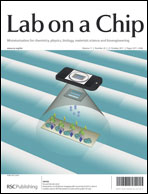Effective pressure and bubble generation in a microfluidic T-junction†
Abstract
To improve the existing trial-and-error process in designing a microfluidic T-junction, a systematic study of the geometrical (mainly the channel length) effects on the generated bubbly/slug flow was conducted to figure out basic design guidelines based on experimental and theoretical analyses. A driving system with dual constant pressure sources, instead of the commonly used dual constant volume-rate sources (such as two syringe pumps), was chosen in this study. The newly proposed effective pressure ratio (Pe*) has revealed its advantages in excluding the surface tension effect of fluids. All the data of generated bubbly/slug flow for a given geometry collapse excellently into the same relationship of void fraction and effective pressure ratio. This relationship is insensitive to the liquid viscosity and the operation range is strongly affected by the geometrical effect, i.e., the channel length ratio of downstream to total equivalent length of the main channel in a T-junction chip. As to the theoretical design and analysis of gas–liquid-flow characteristics in a microfluidic T-junction, which is still sporadic in the literature, the proposed semi-empirical model has successfully predicted the operation boundaries and the output flow rate of bubbly/slug flow of different investigated cases and demonstrated its usability.


 Please wait while we load your content...
Please wait while we load your content...